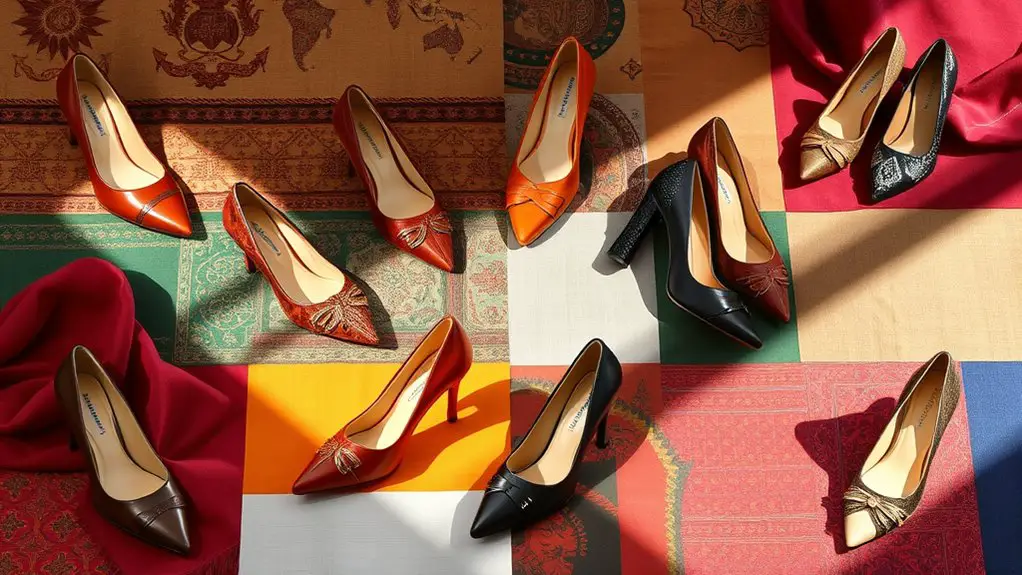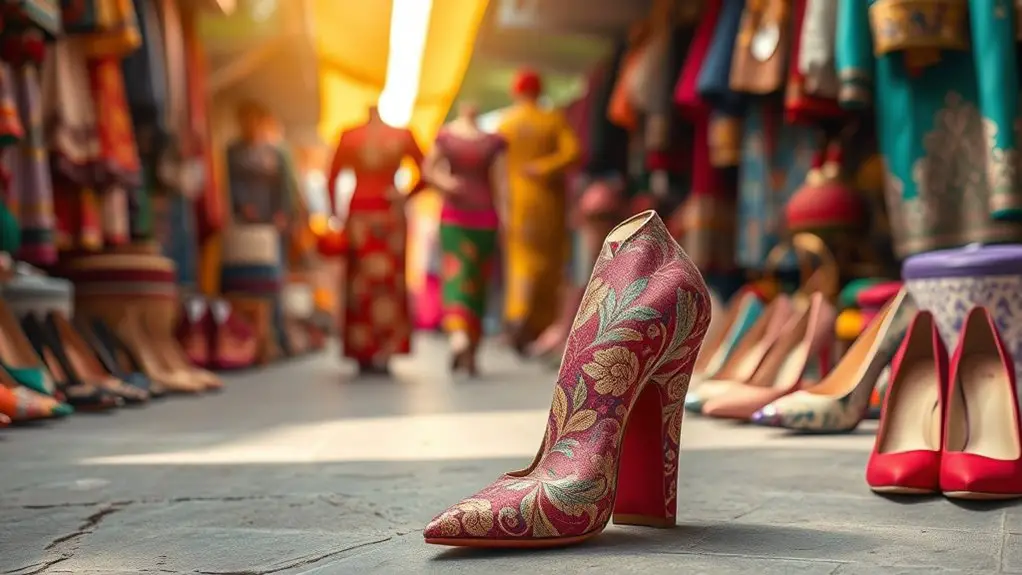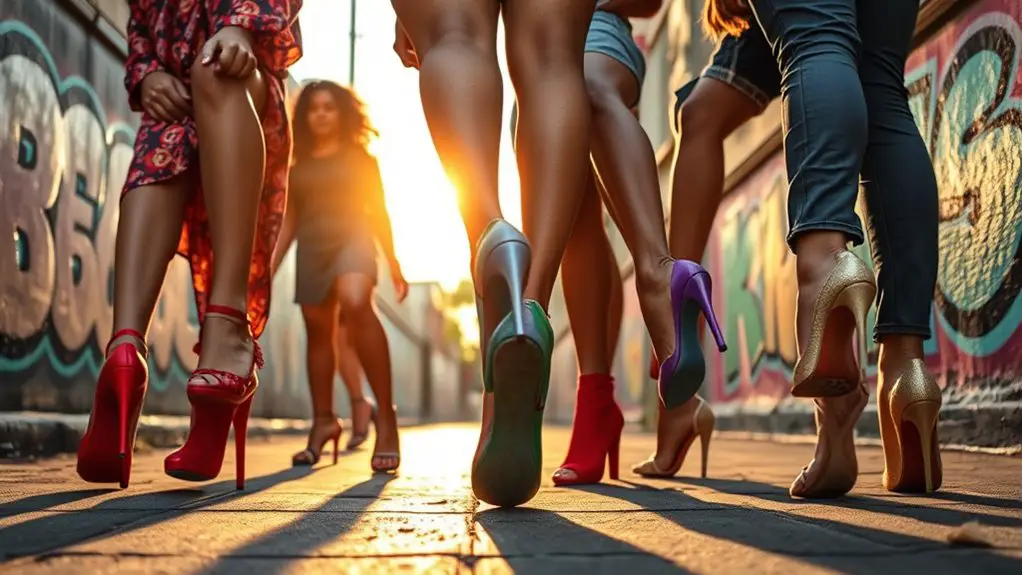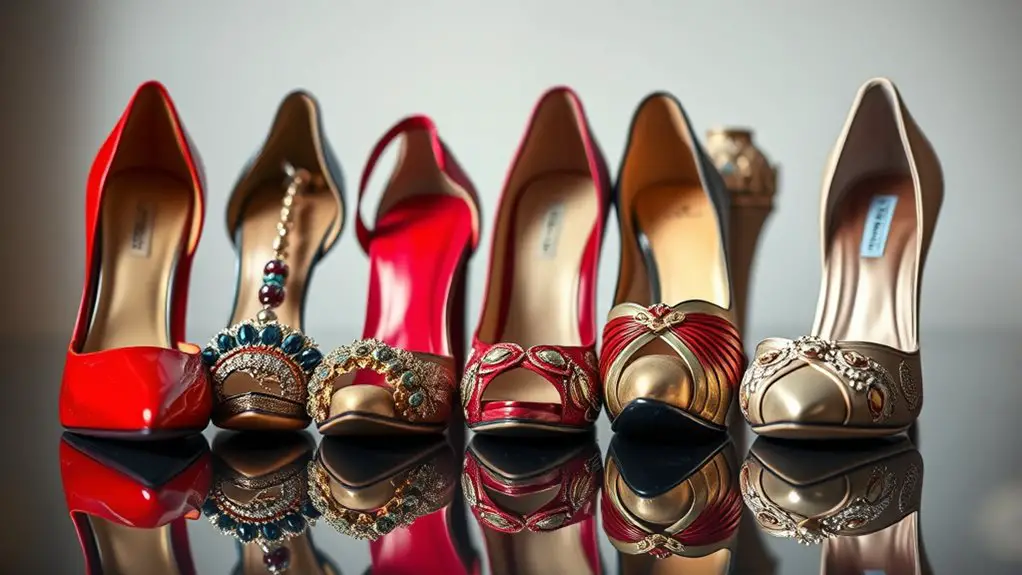High heels hold significant cultural meanings in many countries. In Western societies, they symbolize femininity and strength, enhancing confidence and social status. Meanwhile, Asian cultures often view high heels as a representation of grace and sophistication. In Middle Eastern societies, they reflect wealth and modernity, while contemporary feminism embraces them as tools of self-expression and rebellion against traditional norms. Their evolving meanings and styles highlight the complexities of cultural identity across the globe, revealing deeper narratives waiting to be uncovered.
The Origins of High Heels: A Historical Perspective

Although high heels are often associated with modern fashion and femininity, their origins reveal a complex history that transcends mere aesthetics. You might be surprised to learn that high heels date back to ancient footwear, with evidence found in ancient Persia, where they served practical purposes for cavalry soldiers. However, their royal significance emerged in Europe during the 16th century. Kings and nobles donned heels not just for height but as symbols of status and power. This choice wasn’t purely about style; it communicated authority and exclusivity. As you explore this history, you’ll notice that high heels have often blurred the lines between functionality and fashion, reflecting societal values and hierarchies. This interplay of practicality and privilege underscores how high heels have evolved, encapsulating a narrative that’s as rich as the materials used to craft them.
High Heels in Western Culture: Empowerment and Elegance
Empowerment and elegance intertwine in the cultural narrative of high heels, reflecting broader societal shifts in Western culture. These iconic shoes symbolize a blend of femininity and strength, transforming how you perceive your presence in various spaces. High heels serve as more than just fashion; they embody empowerment narratives that challenge traditional gender roles and express individuality.
Here are three ways high heels manifest this duality:
- Boosting Confidence: The elevation enhances posture, making you feel more assertive and self-assured.
- Artistic Expression: Styles range from classic pumps to avant-garde designs, allowing you to showcase personal taste and creativity.
- Cultural Statements: High heels often signify social status, becoming tools for women to navigate professional and social arenas.
In Western culture, high heels become powerful elegance expressions, encapsulating the complex dynamics of beauty, ambition, and self-identity.
The Role of High Heels in Asian Fashion Traditions

While high heels are often associated with Western fashion, they also play a significant role in Asian fashion traditions, where they carry unique cultural connotations and stylistic expressions. In many Asian cultures, high heels reflect traditional symbolism, often representing femininity, grace, and status. For instance, in countries like China and Japan, the craftsmanship of high heels showcases intricate designs inspired by local aesthetics, merging traditional artistry with contemporary flair.
Modern interpretations of high heels in Asia illustrate a cultural fusion, blending Western influences with indigenous styles. You’ll notice how vibrant colors and patterns often adorn these shoes, making them a statement piece. This evolution highlights a growing appreciation for high heels not just as footwear, but as a canvas for cultural expression. Ultimately, high heels in Asian fashion are more than just a trend; they embody a dialogue between heritage and modernity, inviting you to explore diverse perspectives in style.
High Heels as a Status Symbol in Middle Eastern Societies
High heels in Middle Eastern societies often transcend mere fashion, serving as a potent status symbol that reflects wealth and social standing. In these contexts, high heels aren’t just about style; they signify a deeper status representation shaped by societal expectations. When you see someone in extravagant heels, consider the following:
- Cultural Heritage: High heels may embody traditional values while also embracing modernity, showcasing a blend of old and new.
- Social Events: They’re often worn at weddings and gatherings, where appearance can dictate one’s social standing.
- Luxury Brands: Owning designer heels signals affluence, aligning closely with the desire for exclusivity and prestige.
In this way, high heels become a means of maneuvering through societal norms, where the height of your heel can reflect the height of your status. Understanding this dynamic offers insight into the intricate relationship between fashion and identity in Middle Eastern cultures.
The Rebellion of High Heels in Contemporary Feminism

You might notice that high heels have transformed from mere fashion statements to symbols of empowerment within contemporary feminism. As women reclaim their footwear choices, they’re challenging traditional beauty standards and using heels as tools of protest against societal norms. This rebellion not only redefines femininity but also sparks conversations about autonomy and self-expression in a world that often dictates how women should look.
Empowerment Through Footwear Choices
As society evolves, so too does the meaning behind high heels, transforming them from mere fashion statements into symbols of empowerment within contemporary feminism. You might notice how these shoes now carry deeper empowerment narratives, challenging traditional norms.
Here are three ways high heels embody this shift:
- Reclaiming Femininity: High heels allow women to embrace their femininity without apology.
- Footwear Symbolism: They serve as a bold statement against societal expectations, showcasing strength and confidence.
- Personal Expression: Wearing heels becomes a personal choice, allowing you to define your identity on your own terms.
In this context, high heels demonstrate how fashion can transcend aesthetics, becoming a powerful tool in the fight for equality and self-expression.
Challenging Beauty Standards
The evolution of high heels not only reflects personal empowerment but also serves as a battleground for challenging entrenched beauty standards. As you observe the contemporary landscape, you’ll notice how high heels symbolize shifting perceptions of femininity and attractiveness. Women are reclaiming this iconic footwear, asserting that it doesn’t dictate their worth but rather enhances their individuality. This rebellion encourages beauty diversity, showcasing that style can be personal rather than prescriptive. By embracing high heels in various expressions, you witness a collective push against narrow ideals that have long dominated fashion. It’s about more than just height; it’s about confidence, choice, and the right to define beauty on your own terms—an ongoing dialogue that continues to shape cultural narratives.
High Heels as Protest
While high heels have often been associated with glamour and femininity, they’ve increasingly become a symbol of protest in contemporary feminism. Women have reclaimed these stylish shoes to make powerful political statements during protest marches. Here are three notable ways high heels serve as a form of rebellion:
- Visibility: High heels draw attention, allowing wearers to stand out in a crowd while voicing their demands for equality.
- Subversion: By wearing heels, women challenge traditional gender norms, flipping the narrative of femininity on its head.
- Unity: Groups often coordinate to wear heels as a collective symbol, creating a striking visual representation of solidarity.
In this context, high heels transform from mere fashion into tools of empowerment, redefining their cultural significance in the feminist movement.
High Heels in African Cultures: Tradition Meets Modernity
Though high heels often evoke images of Western fashion, they hold a unique place in various African cultures where tradition intertwines with modernity. In many African communities, high heels symbolize status and femininity, reflecting both tribal influences and contemporary aesthetics. You might notice how traditional attire is sometimes complemented by modern adaptations of high heels, merging cultural heritage with urban chic.
For instance, at weddings or festivals, women may wear vibrant traditional dresses paired with striking heels, creating a stunning visual contrast. This blend showcases a celebration of cultural identity while embracing modern fashion trends. As you observe, high heels can also serve as a form of self-expression, allowing women to assert their individuality in a rapidly changing society. Ultimately, the journey of high heels in African cultures illustrates a dynamic interplay between the past and the present, highlighting the richness of cultural evolution.
The Global Influence of High Heels: From Runways to Everyday Life
You might notice how high heels have shifted from exclusive runway statements to staples in everyday wardrobes across the globe. This shift not only reflects changing fashion industry dynamics but also highlights the cultural symbolism and identity tied to these iconic shoes. As you explore this evolution, consider how high heels influence both personal style and collective trends in various societies.
Fashion Industry Impact
High heels have transcended their origins to become a global fashion phenomenon, influencing everything from high-end runways to everyday wardrobes. You’ll notice their impact in various ways:
- Luxury Brands: High heels are a staple in luxury fashion, often seen as symbols of status and sophistication.
- Sustainability Issues: The production of high heels raises concerns, as the demand for fast fashion can lead to environmentally harmful practices.
- Cultural Adaptation: Different countries adapt high heels to their unique styles, reflecting local trends while maintaining global appeal.
As you navigate the fashion landscape, it’s evident that high heels are not just footwear; they’re a reflection of cultural values, consumer behavior, and the ongoing dialogue around sustainability in the fashion industry.
Cultural Symbolism and Identity
While many see high heels as mere accessories, they serve as powerful symbols of identity and cultural expression across the globe. You might notice how high heels reflect cultural identity, varying greatly between countries and communities. In some cultures, they symbolize femininity and empowerment, while in others, they represent status and sophistication. Fashion symbolism plays an essential role here; the height and design of a heel can convey rebellion or adherence to tradition. You’ll find that high heels can elevate not just your stature but also your social standing, becoming a canvas for individual expression. As you observe different styles globally, you’ll realize that high heels transcend mere fashion—they embody the complexities of cultural narratives and personal identities.
Everyday Fashion Trends
As the fashion world continuously evolves, high heels have shifted from the glamorous runways of haute couture to the sidewalks of everyday life, influencing trends around the globe. You’ll notice how these stylish shoes embody casual elegance while complementing the urban chic aesthetic.
- Block heels have risen in popularity for their comfort and versatility.
- Kitten heels offer a playful nod to retro styles, perfect for both work and play.
- Stiletto boots are now a staple for those looking to add flair to their winter wardrobe.
High heels, once reserved for special occasions, have become essential in daily fashion, showcasing how footwear can transform even the simplest outfits into statements of style and confidence.
Frequently Asked Questions
Are High Heels Uncomfortable for Most Women?
You’d think high heels are torture devices! Many women endure high heel discomfort for the sake of fashion choices. Sure, they look fabulous, but at what cost? Comfort often takes a backseat to style, doesn’t it?
How Do High Heels Affect Posture and Health?
High heels influence your posture alignment considerably. Their biomechanics can shift your center of gravity, leading to potential discomfort and health issues. It’s essential to contemplate how they affect your body over time.
What Materials Are Commonly Used to Make High Heels?
When selecting high heels, you’ll find a variety of materials. Common choices include different leather types for durability, while sustainable materials like recycled plastics or organic fabrics are becoming increasingly popular, reflecting a shift towards eco-conscious fashion.
Can Men Wear High Heels in Different Cultures?
In various cultures, men can wear high heels as a form of gender expression, challenging traditional fashion norms. It’s fascinating how perceptions shift, allowing footwear once deemed feminine to become a bold statement of individuality.
How Have High Heels Evolved in Terms of Design Trends?
High heels have transformed spectacularly, haven’t they? Design influences range from avant-garde to vintage, while cultural symbolism shifts dramatically. You’ll notice how trends reflect society’s values, merging fashion with deeper meanings throughout history.



